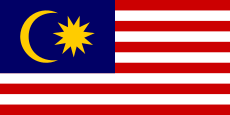Tunku Osman
Tunku Tan Sri Osman (1919 – 19 April 1994) was the first Malaysian Armed Forces Chief of Staff. He is a nephew of Tunku Abdul Rahman, Malaysia's first Prime Minister as well as a first cousin to the late Sultan Abdul Halim, the late Tunku Abdul Malik, the late Tunku Annuar and Sultan Sallehuddin since their fathers and The Tunku are brothers (paternal half siblings). General Tunku Osman was known for his strong principles and self-discipline as well as highly respected by the ranks and files of the army.
Tunku Osman Tunku Mohd Jewa | |
|---|---|
| Born | 1919 Kedah, British Malaya |
| Died | April 19, 1994 (aged 74–75) Kuala Lumpur, Malaysia |
| Buried | |
| Service/ | |
| Years of service | 1937-1969 |
| Rank | General, Chief of Armed Forces |
| Battles/wars | World War II, Malayan Emergency, Malaysia-Indonesia Confrontation |
Background
Tunku Osman received his early education at the Hutchin School, Penang and later enrolled into the Sultan Abdul Hamid College (SAHC), Alor Star, Kedah. On March 1935, he furthered his studies at the Bristol Grammar School, England. There, he was taken care of and guided by Reginald James MacGregor. When the war broke in Europe, Tunku Osman showed his interest in joining the armed forces when R.J. McGregor's sons joined the Royal Air Force.
Career highlights
From April to August 1942, Tunku Osman trained with the Gloucester Regiment as a recruit and later joined the 80th Reconnaissance Regiment. He was then sent undergo cadet training at the Highland Fieldcraff Centre in Scotland. He underwent further training at Bovington and was seconded to the Royal Armoured Car Regiment. In 1944, he entered the OCTU at Barmouth, Wales on December 1944 to undergo training as a cadet officer.
In 1945, Tunku Osman joined the Force 136 and was commissioned as second lieutenant (May 1945) and was absorbed into the General List. He continued parachute training and investigations at Calcutta, India. He spearheaded the Malay Guerrilla Group when Force 136 was abolished after surrender of Japan.
In 1946, Tunku Osman joined the British Military Administration (BMA) in Malaya and served in the British Army in Malaya. In 1947 Tunku Osman joined the Royal Malay Regiment (1 February 1947) and was commissioned as lieutenant and assigned to the 2nd Battalion Malay Regiment. He was promoted to captain in February 1951 and later to the rank of major in 1955. The same year, Tunku Osman was sent to attend a Senior Officers course at Devizes, Wiltshire. In 1958, Tunku Osman was assigned to the 6th Battalion and the 7th Malay Regiment as Assistant Commanding Officer.
In July 1958, Tunku Osman was promoted to lieutenant colonel and took command of the 2nd Battalion Malay Regiment. He was the first Malay Commanding Officer of the battalion. In May 1960, Tunku Osman was promoted to the rank of colonel while he was attending the Joint Services Staff College and in June 1960 was promoted to brigadier general and took command of 2nd Malayan Infantry Brigade. In July 1961, Tunku Osman was made "Brigadier of The Army" at the Ministry of Defense.
Appointment as Chief-of-Staff of the Armed Forces
When General Tan Sri Sir Rodney Moore retired as the Chief of Staff of the Armed Forces, Tunku Osman was promoted to major general and appointed as the Chief of Staff of the Armed Forces. He was the first Malayan to hold the highest rank in the Malaysian Armed Forces. Tunku Osman retired from his position on 24 November 1969.
Honours
For his many services and contributions, he was conferred various medals and honours:
- National Order of Vietnam, Grand Officer (2nd Degree) (South Vietnam)
- Order of Diplomatic Service Merit, Heung-In (2nd Class) (South Korea)
- Order of Sikatuna, Grand Cross (Datu) (The Philippines)
- Order of the Crown, Grand Commander (Imperial State of Iran)
- Order of the Star of Ethiopia, Grand Officer (2nd Class) (Ethiopian Empire)
- Order of the White Elephant, Knight Grand Cross (1st Class) (Thailand)
- Burma Star (United Kingdom)
- British War Medal (United Kingdom)
- Defence Medal (United Kingdom)
He was also bestowed the Malaysian order of chivalry which carries the title 'Tan Sri'.
Honours of Malaysia


Death and burial
He died on 19 April 1994 at the age of 76 and was buried near Tunku Abdul Rahman's grave at Kedah Royal Mausoleum at Langgar.[3]